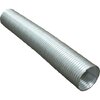Here is an old post of my experience with a lossy feed line on my Starduster many years ago. At that time, when a few CB buddies made me aware that I had a low signal issue, I was curious, but I had no understanding of losses...except thinking losses sounded real bad with regards to antenna gain and a low signal. Click link below.
SWR HAPPENINGS ?
Thus far, all of my models of the RRDD antennas were lossy, because they all show to have a very low ohmic feed point impedance, generally less than <1 OHM with varying values of reactance as well.
My PDF model below, attached to the cab of a pickup truck model about 8" inches below, shows a match >100 ohms,
lots of loss in the match. With such a match, the gain shows -1.35 dbi at 27* degrees...
which is not bad for a mobile antenna only 120" inches above real Earth. That said however, I don't think it will work well with your transmitter unless it is tuned somehow.
IMO, this supports the idea that this antenna is very lossy. This antenna's efficiency is less than 3%, and has been reported in numerous articles. It seems to be a characteristic for this design.
IMO, this may account for the very quiet operations we read reported in my post #49 above, "...the receiver is dead quiet and the meter is on zero". Hams in the same article reported how quiet it was. My personal link at the top of this post also reports way back...that I had a similar receiver response when I was using a very lossy feed line on my Starduster.
I think is was Jeff's link below, that also confirms this antenna is a fire breather, producing sparks and smoke. The DDRR is also referred to as being a magnetic type of antenna, and therefore is said to be detrimental to nearby modern electronics, also in the article. Click here:
http://orionmicro.com/ant/ddrr/ddrr1.htm
Maybe this magnetic antenna is what excited both Mustang 31 and Motor Mouth Maul as noted in the video link I posted and in 31's post. I also noticed in MMM video he was in a very old truck and maybe that explains why, no modern electronics. Possibly more clues as to what was going on that could be a problem with the DDRR. IMO, if this antenna was such a remarkable performer...why is it seemingly in mothballs and so secretive today.
We need a good article exposing this antenna for what it really is. I'm going to check on W8JI's website and see if he has something to add about this antenna.
The article also tells us the USN Wheeler transmitters each produced 10,000 watts. 31 claimed he used a big amp and that MMM did also. Maybe this is what this antenna needs in order to transmit a strong signal, being as it is so inefficient.
I believe the reports about the DDRR being very quiet when on the air, because I remember the responses I got with my lossy feed line, while I heard other's around me complaining about noise on their rigs. I just didn't know why...and all the while I thought it was because I used a simple Starduster.
Hey 31, were you able to get this antenna matched, and if so how did you do that?
Or, did you guys have to use a heavy duty tuner to match the coax to the radio when using a high power amp?
Did the antenna also produce fire, smoke, and sparks like MMM showed us with the amp on?
Models below were made per specs from Peter Dodd, G3LDO, West Sussex, 1996 (silent key) in his second edition of "The Antenna Experimenter's Guide."
IMO, the DDRR is very inefficient due to the heavy feed point loss, and would seem to require a lot of watts to produce a decent signal...if it could be matched some how.
Here I can also report this model shows VERTICAL gain, but the angle still remains high at 27* degrees above the horizon. I suspect this is due to the mobile ground plane used vs. 1/4 wave radials I used earlier. This may be why we see this multi-band version being use on a ship over sea water...to noticeable lower the TOA over a, more or less, infinite ground plane.
Models below:
1. is a rectangle DDRR. It is 120" inches high attached to the roof of a simple pickup truck cab. This model has no matching device included, and it is over Eznec's idea for a real Average Earth. It shows a typical very low feed point impedance, value of R = 0.6219 OHMs, with -70.49 OHMs of capacitive reactance, with SWR > 100 OHMs.
2. is the same model as #1, except I forced the model to show a perfect match, noted as FTM in the model's title. This gave the model a good match and forced the losses to show up as gain losses instead of feed point losses.





